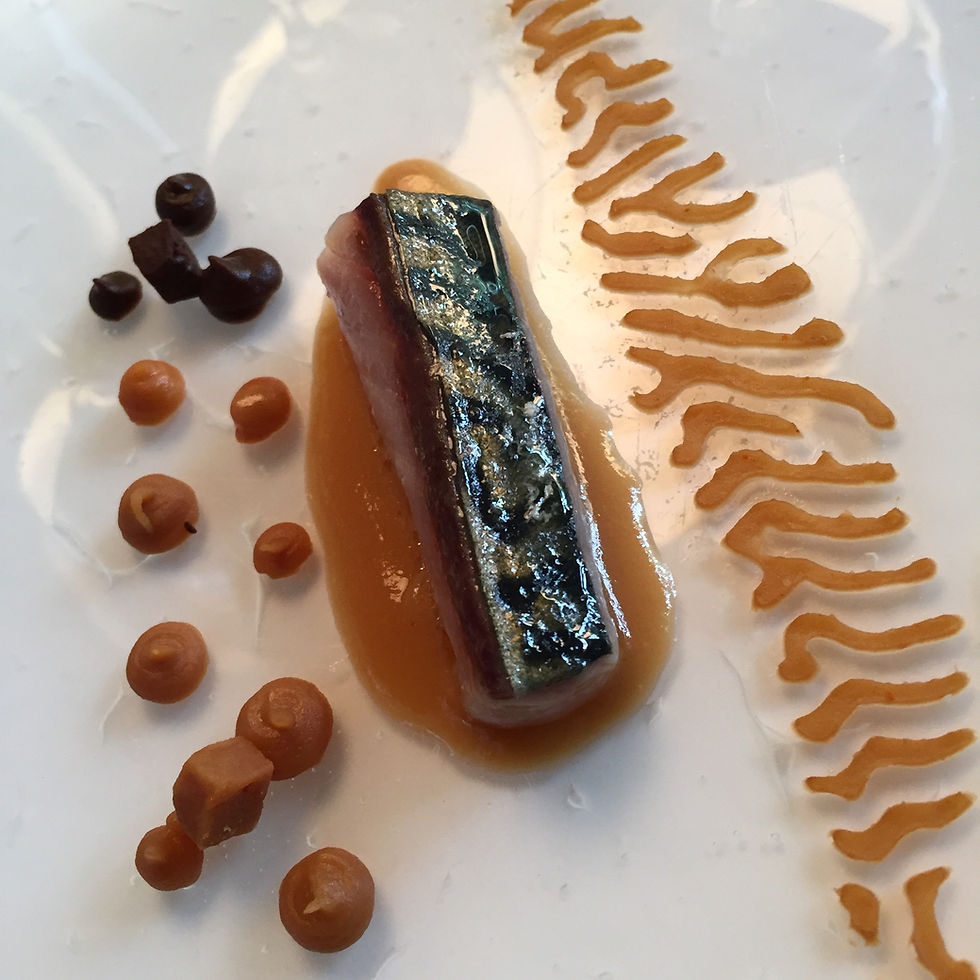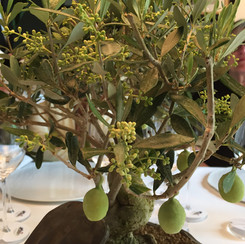To Spain for Lunch: Pazo de Señorans at El Celler de Can Roca
- Joanna Simon

- Jun 7, 2017
- 5 min read
Updated: Apr 24, 2023

Clockwise from top left: Starfish made of seafood; Mackerel with fermented ganxet beans; White asparagus with mullet bottarga, vegetable demiglace, cauliflower purée, elderflower, apricot and hazelnut (no comment on the appearance); Calcots – fermented, charcoal-grilled and crispy – with eel, fava bean sauce, aioli and bay jelly
If I’m really honest it wasn’t the prospect of the day’s tasting that got me out of bed at 4.20am to go to Spain for the day: it was lunch. If I say Girona, some of you will immediately speculate… and you’d be right. Lunch was at El Celler de Can Roca, the three Michelin star Catalonia restaurant that has twice been ranked number one in The World’s 50 Best Restaurants and is currently a none too shabby number three (I anticipate your every question: this year Eleven Madison Park is number one, Osteria Francescana is number two and Heston comes in at 36 with Dinner By Heston Blumenthal, London; The Clove Club and The Ledbury pip Heston at 26 and 27, respectively).
Don’t get me wrong. The wines were tempting, but we’re not in the realms of Domaine de la Romanée Conti or Pétrus. We’re in Spain. No, not Pingus or Vega Sicilia either – do stop guessing. The tasting is “a historical vertical” of Pazo de Señorans, which means white wine made at one estate from a single grape variety, Albariño, in Rías Baixas (about as far on the other side of the country as you can get from Girona, as it happens). The wines are being tasted at lunch, each vintage matched to the food by sommelier Josep Roca, who, with his elder brother Joan, the chef, and younger brother Jordi, the pastry chef, own and run this exceptional restaurant. The idea is to demonstrate the quality, ageing ability and food matching potential of Albariño and specifically, obviously, Pazo de Señorans. Our host, founder and co-owner of the estate, Marisol Bueno, says at the outset, “a great wine is one that can be aged”.
El Celler de Can Roca sommelier Josep Roca (with me) and, right, Marisol Bueno, co-owner and founder of Pazo de Señorans
A bit of background. The Pazo de Señorans estate, in the Val do Salnés sub-zone of Rías Baixas, is centuries old but was bought in 1979 by Marisol Bueno and her husband Javier Mareque. Albariño was already growing in the weathered granite soils but the couple didn’t make wine commercially until they launched the 1989 (a modest 7000 bottles compared to today’s total production of 300,000).
With the 1995 vintage came second wine, Selección de Añada. This is an aged wine –14 months for the debut vintage, 30 months now – but always in stainless steel, not oak. The other essential that distinguishes Selección from the young wine is that the grapes come from a single low-yielding vineyard, the estate’s oldest and highest, whereas two thirds of the grapes in the young wine come from 130 local families, some of which have been suppliers from the beginning.
Pazo de Señorans has released one oaked wine, Sol de Señorans 2006, aged in oak for six months in 60% French and 40% Caucasian 500-litre barrels. Although Ana Quintela Suárez, winemaker since 1991, continues to experiment with oak, especially large vessels, and the 2006 Sol was well received, there hasn’t been another vintage that Marisol and she have liked enough to release. For the record, the ’06 showed very well at the tasting-lunch: rich and concentrated with the oak integrated and balanced by the high acidity – but the oaked complexity comes at the expense of some of the Albariño purity and character. The wine was a perfect match, however, for the dish it accompanied, flower of onion with Comté cheese (sauce), with walnuts caramelised, curried and in bread.
Instead of further oaked wines, they have added a late-release line called Pazo de Señorans Collección. So far the 2011, 2012 and 2013 have been released. The wine is made in the same way as the young wine, but the grapes come entirely from selected micro-plots on the estate.
When you look at the menu below, you'll understand why I’m not going to give a blow-by-blow account of the food. I’ve just counted the number of dishes – I hesitate to call them courses. There were 21. No wonder I almost missed my return flight. No wonder, when I got home just before midnight, I still didn’t want anything further to eat.
Left to right: you can't have too many glasses of Pazo de Señorans in front of you: a dish called Memories of a Bar in the Suburbs of Girona (see menu below); Green-olive ice cream – the 'olives' were the edible part; Molluscs with the flavours of Albariño – clam with apple, cockle with apricot, mussel with soil/air, clam with bay, oyster with grapefruit mayo
What I will say is that Pazo de Señorans’ Albariños shone. The food was brilliant – complex in taste, texture and technique and, in the case of the green-olive ice cream, in temperature too – but the wines were up to the job. The young wines have a tight-knit intensity of flavour (peach, quince, citrus, green apple, salty minerality) and natural high acidity. The aged wines have all that, plus greater density, richer texture and, as they get older, a honeyed edge to the minerality. For those who don’t like the word minerality, there is no alternative (sorry about the italic emphasis, I must have been at the receiving end of too many election rants).
Left to right: Flower of onion with Comté cheese and walnuts, carmelised, curried and in bread; Hake cheeks with pil pil and pickled vegetables; Turbot canneloni stuffed with sea cucumber and sea anemone; Prawn marinated in rice vinegar, prawn head sauce, seaweed and plankton velouté
The wines we tasted are listed below. If I had to highlight a few vintages, I would say look out for the 2016, 2010 and, if you're lucky enough to find it, the 2001. Marisol Bueno thinks 2001 is the best ever. We had it from magnums with turbot cannelloni, the cannelloni made from the turbot skin stuffed with sea cucumber and sea anemone served with a plankton sauce, and then with Iberian suckling pig with a salad of green papaya, Thai grapefruit, apple, coriander, chilli, pear, roses and red grapefruit.
Left to right: Langoustine with sage, vanilla oil and toasted butter; St George's mushroom and Summer truffle brioche; Oyster in five parts – with apple, mushroom, seaweed, truffle, and lemon with sauce of fennel and black garlic
What I haven’t yet said is that, in a lifetime of dining out and cooking in and listening to too much theorising, I have never experienced such skillful wine and food pairing. I like to think I know a bit about this subject (have I mentioned my book Wine With Food before? Surely not?), but the delightful, unassuming Josep Roca is in a league of his own. As are his brothers.
The wines
Pazo de Señorans 2016, 2015, 2014, 2010, 2009,
Sol de Señorans 2006,
Pazo de Señorans Selección de Añada 2008, 2007, 2005, 2004 and, in magnum, 2001, the vintage that Marisol Bueno thinks is the best ever.

Pazo de Señorans is one of very few remaining wineries to distill its own spirits from the grape skins – twice distilled in copper pot stills. Three were served with the three desserts: Aguardiente de Orujo de Albariño, Aguardiente de Hierbas and Aguardiente de Vino Envejecido 2005.
The desserts were: Green colourology (left), apple yuzu, avocado, mint and bazil; Orange colourology; and Cuban cigar box – chocolate with milk, vanilla, dried plum, tobacco leaf and cocoa.

Lunch at El Celler Can Roca – the menu
Stockists of Pazo de Señorans wines include The Vinorium, Davis Bell McCraith, Berry Bros & Rudd, Hedonism and Hennings Wine.
You can visit Pazo de Señorans if your book ahead. They offer customised visits with other visitors or solo. pazodeseñorans.com; +34 986 715 373; info@pazodesenorans.com.
Photographs by Joanna Simon


































Comments